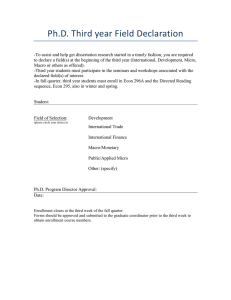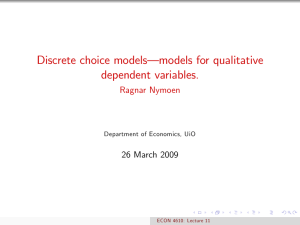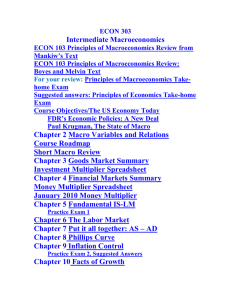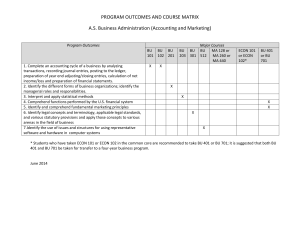Systems of linear regression equations or SURE (Seemingly Unrelated Regression) Ragnar Nymoen
advertisement
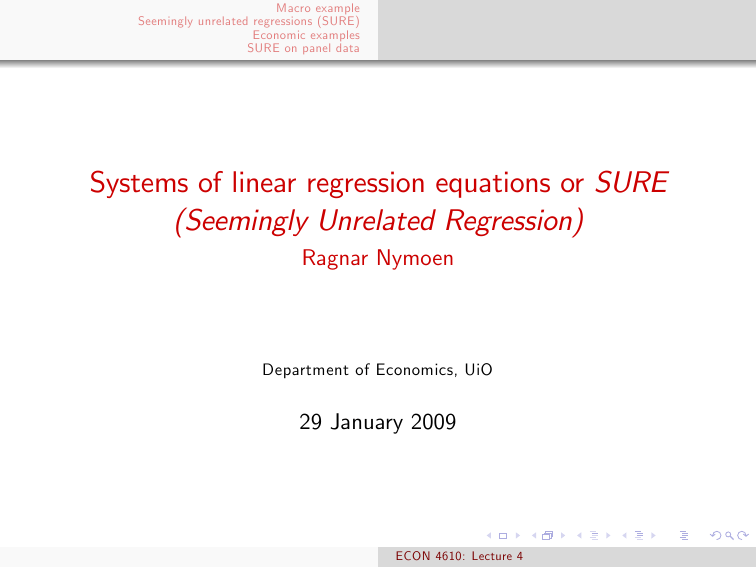
Macro example Seemingly unrelated regressions (SURE) Economic examples SURE on panel data Systems of linear regression equations or SURE (Seemingly Unrelated Regression) Ragnar Nymoen Department of Economics, UiO 29 January 2009 ECON 4610: Lecture 4 Macro example Seemingly unrelated regressions (SURE) Economic examples SURE on panel data Overview This is topic 4 in the lecture plan Systems of regression equations SURE as GLS Relationship to OLS. SURE on panel data Main reference is G Ch 10.1 and 10.2;. B Ch 4, 5.4, 5.5, 6.3a, 6.4a; 6N: B; K: Ch 10.1 ECON 4610: Lecture 4 Macro example Seemingly unrelated regressions (SURE) Economic examples SURE on panel data Let Yt denote GDP in period t D 1, 2, ..., T . Ct is “endogenous expenditure” and let Xt denote “exogenous expenditure”. Assume that Ct depends on GDP, then our example model is Yt D Ct C Xt (1) D b1 C b2 Yt C "t , b2 Ct 0 (2) The Reduced is form: Yt Ct D 11 C D 21 C 12 Xt 22 Xt C 1t (3) C 2t (4) Assume that the disturbances " t are independenty normally distruted with zero means and constant variances, and that our parameters of interest are the multipliers 12 and 22 . ECON 4610: Lecture 4 Macro example Seemingly unrelated regressions (SURE) Economic examples SURE on panel data Macro example, cont’d How can we estimate our parameters of interest? OLS on (3) and (4) separately? OLS is unbiased. Something to gain in e¢ ciency, from joint estimation of the two equations? After all, they are only seemingly unrelated: 1t and 2t are correlated by construction. There are restrictions on the coe¢ cients. For example, 11 D 21 . Is there something to gain from incorporating coe¢ cient restrictions into the estimated procedure? We concentrate on the correlated disturbances— at the some remarks about how to incorporate coe¢ cient restrictions. ECON 4610: Lecture 4 Macro example Seemingly unrelated regressions (SURE) Economic examples SURE on panel data Matrix notation Use the same notation as before, but for two regression models: y1 D X1 y2 D X2 1 2 C "1 , and C "2 each X matrix has n (or T ) rows. The number of explanatory variables may be di¤erent, hence K1 and K2 for the number of regressors, and coe¢ cients in 1 and 2 . The two disturbance vectors have classical properties E ["i ] D 0 Var ["i ] D 2 i I, i D 1, 2 The conditioning on the respective X matrices is implicit. ECON 4610: Lecture 4 Macro example Seemingly unrelated regressions (SURE) Economic examples SURE on panel data Stacking We can write the two regression models as one equation by …rst 0 stacking y1 and y2 into a 2n column vector y D y1 y2 , and then stacking the right hand sides of the two regressions in a similar way: y1 y2 X1 0 0 X2 y D X C" D 1 2 C "1 "2 (5) (6) (6) looks like a usual regression model. But care must be taken, because the variance of " is obtained by taking expectations of " "0 D "1 "01 "1 "02 "2 "01 "2 "02 If E ["1i "2i ] D 12 0 while E ["1i "2j ] D 0 for i 6D j, we have the analogue to a heteroscedastic covariance matrix. ECON 4610: Lecture 4 Macro example Seemingly unrelated regressions (SURE) Economic examples SURE on panel data The structure of the variance matrix E ["1i "2i ] D 12 0 written as E ["1 "02 ] D 12 I together with E ["1 "01 ] D 2 1I and E ["2 "02 ] D 2 2I gives Var ."/ D D 2 1I 12 I 2 1 12 12 I 2 2I 12 2 2 (7) ID6 I •. for the (stacked ) disturbance vector in the regression model y D X C ". ECON 4610: Lecture 4 Macro example Seemingly unrelated regressions (SURE) Economic examples SURE on panel data We know from Lecture 3 that in this case GLS is e¢ cient bGLS 1 .X0 • 1 X/ X0 • 1 y h i 1 1 X0 [ 6 D .X0 [6 I] X/ D (8) 1 I] y We see that the SURE estimator involves the elements of 6 Write these as ij (see Greene p 256) bSURE D 11 X0 X 1 1 21 X0 X 2 1 12 X0 X 1 2 22 X0 X 2 2 1 11 X0 y 1 1 21 X0 y 2 1 ECON 4610: Lecture 4 C C 1. 12 X0 y 1 2 22 X0 y 2 2 (9) Macro example Seemingly unrelated regressions (SURE) Economic examples SURE on panel data If b 12 SURE D D 21 D 0 then 11 X0 X 1 1 01 0 22 X0 X 2 2 1 11 X0 y 1 1 22 X0 y 2 2 D .X01 X1 / 1 X01 y1 .X02 X2 / 1 X02 y2 If the models are unrelated, then the GLS/SURE estimator is identical to OLS on each of the two models. No e¢ ciency gain, or improved inference, from using SURE/GLS. ECON 4610: Lecture 4 . Macro example Seemingly unrelated regressions (SURE) Economic examples SURE on panel data Identical regressors Consider the case that the two models have the same regressors: X1 D X2 bSURE D D [6 D [6 11 .X0 X / 1 1 21 .X0 X / 1 1 1 .X01 X1 /] .X01 X1 / 1 ] 1 12 .X0 X / 11 X0 y 1 1 1 1 22 .X0 X / 21 X0 y 1 1 1 1 11 X0 y C 12 X0 y 1 1 1 1 2 21 X0 y C 22 X0 y 1 1 1 2 11 X0 y C 12 X0 y 1 1 1 2 21 X0 y C 22 X0 y 1 1 1 2 ECON 4610: Lecture 4 C C 12 X0 y 1 2 22 X0 y 1 2 Macro example Seemingly unrelated regressions (SURE) Economic examples SURE on panel data If OLS is applied on each model then bj D .X01 X1 / 1 X01 yj , j D 1, 2 since X2 D X2 , implying .X01 X1 /bj D X0j yj bS 11 b C 12 X0 X b 1 1 1 2 21 b C 22 X0 X b 1 1 1 2 0 2 0 0 1 1 X1 X1 11 b1 12 .X1 X1 / 1 .X1 X1 / 0 2 0 1 1 X01 X1 21 b1 21 .X1 X1 / 2 .X1 X1 / 2 11 b1 C 21 12 b2 C 12 21 b1 C 12 22 b2 1 11 b C 12 b C 2 21 b C 2 22 b 21 1 21 2 1 2 2 2 2 11 2 12 21 22 b1 . 1 C 12 / C b2 . 1 C 12 / 2 21 2 22 11 12 b1 . 21 C 2 / C b2 . 21 C 2 / D [6 D D D .X01 X1 / 1 ] X01 X1 X01 X1 ECON 4610: Lecture 4 C C 12 X0 X b 1 1 2 22 X0 X b 1 1 2 Macro example Seemingly unrelated regressions (SURE) Economic examples SURE on panel data Write out 66 1 DI as 2 1 21 12 2 2 . 2 1 11 2 1 . 21 21 11 12 21 22 C 12 12 C 11 12 C C 12 2 2 2 2 D I 21 / D 1 22 21 22 D 0 D 0 D 1 From this we see that the SURE estimator becomes bSURE D b1 b1 in the case of identical regressors X1 D X2 . ECON 4610: Lecture 4 Macro example Seemingly unrelated regressions (SURE) Economic examples SURE on panel data SURE vs OLS These result generalize to systems of any number of regression equations. Because of it GLS interpretation, the SURE estimator (for known 6) is more e¢ cient (lower variance) and gives more correct inference than OLS The result that bSURE D bOLS when disturbances are correlated between equations is intuitive But the result that bSURE D bOLS in the case of identical regressors, even though disturbances are correlated, is truly mind boggelig! It also has practical importance. Often, from theory, the regressors are the same for all equations, vf the macro example above. ECON 4610: Lecture 4 Macro example Seemingly unrelated regressions (SURE) Economic examples SURE on panel data Engle functions Let y1 and y2 contain n variables (observations) of family expenditures on two commodities. Let X1 and X2 contain only one explanatory variable: total consumption expenditure in the N families in the sample, all families face the same relative price, which is then subsumed in the constant term of the model. Known as Engle functions, since the main parameter of interest is the Engle derivative or the Engle elasticity. Since X1 D X2 , OLS is e¢ cient (with a caveat) even though there is good reason to believe that the disturbances are correlated. ECON 4610: Lecture 4 Macro example Seemingly unrelated regressions (SURE) Economic examples SURE on panel data Caveat The expenditure on the two goods sum to total expenditure, this should be incorporated into the estimation to ensure both e¢ ciency and logical consistency. This can be attained by working from an explicit functional form of the utility function, and/or by restrictions on 1 , 2 . This caveat extends to system of demand functuions, where we observe variation in goods prices, and therefore have both price and income elasticities as parameters of interest. ECON 4610: Lecture 4 Macro example Seemingly unrelated regressions (SURE) Economic examples SURE on panel data Factor demand Assume a 2 factor Cobb-Douglas function. Cost minimization for a given output level leads to the model y1 D X1 y2 D X2 1 2 C "1 , and C "2 where y1 and y2 contain the n observations of the logs of the volumes of two factors, and X1 D X2 contain intercept, and the logs of real output and the two factor prices. OLS will be an e¢ cient estimator, and the more e¢ cient the more of the restrictions on 1 , 2 implied by theory that we are able on impose. Some of the restrictions are linear and are therefore easy to impose. For example we nominal factor prices by relative factor prices (formally: the restricted least square estimator with R D q as constraint). ECON 4610: Lecture 4 Macro example Seemingly unrelated regressions (SURE) Economic examples SURE on panel data Feasible SURE As with GLS we will in practice need to estimate 6. OLS residuals (from each equation separately) give a consistent estimate of 6, and like in the GLS case this delivers a feasible SURE that is asymptotically e¢ cient In small samples, there may be a trade-o¤ between the gains taking into account the cross equation residual correlation, and the cost of estimating it. ECON 4610: Lecture 4 Macro example Seemingly unrelated regressions (SURE) Economic examples SURE on panel data Panel data: the pooled estimator Assume that yi (i D 1, 2, ...n/ is T 1. Hence we collect data from T time periods in n vectors for the individuals in a cross section. Consistently, Xi (i D 1, 2, ...n/ is T K , and we have the same variables in all Xi s. 2 3 2 32 3 2 3 y1 X1 "1 1 6 y2 7 6 X2 7 6 2 7 6 "2 7 6 7 6 76 7 6 7 4 : 5 D 4 : 54 : 5C4 5 yn Xn "n k D X C" If we assume that all non-zero cross-section residual correlations occur in the same time period, then E ["i "0j ] D ij IT T for all i 6D j and E ["i "0i ] D ECON 4610: Lecture 4 2 i IT T Macro example Seemingly unrelated regressions (SURE) Economic examples SURE on panel data Pooled estimator: structure of variance matrix 2 6 Var ."/ D 6 4 D 6 2 1I 12 I 2 2I 12 I : 1n I IT T .. .. : .. 2n I .. •. 1n I 12 I : 2I n 3 7 7 5 Hence the GLS estimator is this case is equivalent to (8) h bGLS D .X0 [6 i 1 I] X/ 1 X0 [ 6 1 I] y ECON 4610: Lecture 4 (10)
